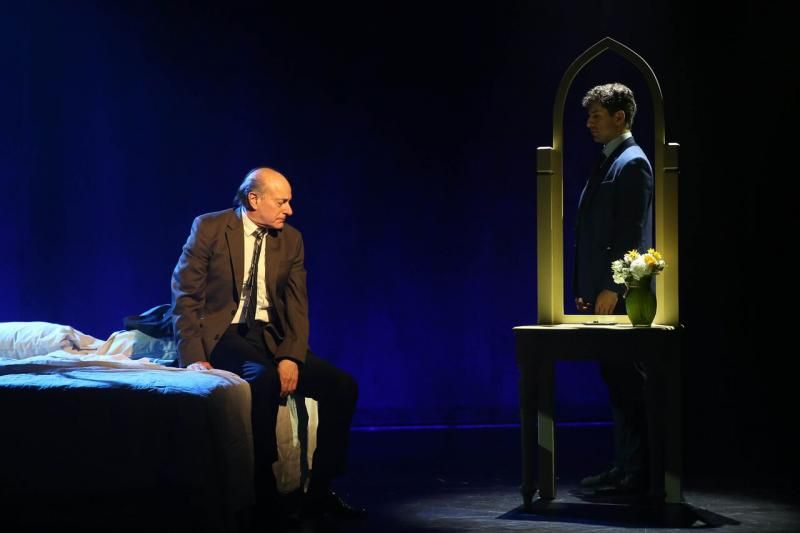Review: John Kander and Susan Stroman Mix Henry James With Henri Matisse in THE BEAST IN THE JUNGLE
From the mid-1960s through to the early years of this century, the musicals scored by the team of John Kander and Fred Ebb have exemplified Broadway pizzazz while exploring darker issues under the glitzy polish.

(Photo: Carol Rosegg)
But since the passing of his lyricist partner, and after completing the unproduced projects they had in progress at the time, Kander's new stage works have been intimate chamber pieces.
And while intimacy describes the feel of his new collaboration, The Beast in the Jungle, it's the fear of intimacy that drives the dance play to its ultimate emotional self-realization.
Utilizing no singing, David Thompson's text is a contemporary story inspired by Henry James' same-named 1903 novella about a fellow named John Marcher, who rather dutifully marches through his fatalist existence in fear of a great tragedy that awaits him like a beast in the jungle.
Though he meets, and feels passion for a woman named May Bartram, he keeps an emotional distance throughout their relationship, not wanting her to suffer from his eventual downfall. Naturally, it's this self-denial of love that is of itself his great tragedy.
Directed and choreographed by Susan Stroman, who always exudes great finesse in allowing storytelling to blend from spoken word to musical interpretations, the 100-minute one-act is beautifully touching and bittersweet.
The fine actor Peter Friedman (Is there anyone better at playing men haunted by unfulfilled dreams?) initially assumes the role of Marcher. Those in the know will immediately recognize the white flowers he carries and the abstract shapes, manipulated by dancers, that form the face of the beast he imagines following him, suggesting the style of Henri Matisse, an artist whose work will figure significantly in the story.
Tony Yazbeck, one of contemporary musical theatre's best at conveying character-specific emotions through dance, enters as Marcher's nephew, an aspiring writer with a knack for being unable to finish his stories. The nephew has once again been tossed from his apartment by his girlfriend, frustrated at his unwillingness to marry her, and once again he pops over to his uncle's for a place to stay.
Marcher is an art dealer, and the conversation quickly turns to a study of Matisse's "The Dance," a recent gift from a friend. This prompts memories of his younger self in the late 1960s, visiting Naples as a lusty, carefree lad in search of, as Marcher puts it, The Great Mystical Fuck.
The scene evolves into 1968 Naples and Yazbeck evolves into 1968 Marcher, who, if he hasn't found exactly what he's looking for yet, is certainly making an effort to find it as he arranges for liaisons with each member of the all-women dancing ensemble; Maira Barriga, Elizabeth Dugas, Leah Hofmann, Naomi Kakuk, Brittany Marcin Maschmeyer, Erin N. Moore.
Kander provides the first of the many varied waltzes he'll supply, providing distinct atmospheric tones for the piece's three global locations; Naples 1968, The Cotswolds in England 1988, and Manhattan 2018. Stroman's choreography is dominated by idyllic ballet sequences, but she also utilizes the contemporary dance language of each period.

(Photo: Carol Rosegg)
Yazbeck's tough, traditionally masculine charisma provides a suitable contrast to the liquidy elegance of Irina Dvorovenko's May. As the story is told through the guy's perspective, the former American Ballet Theatre principal is presented as a soft, idealized version of sophisticated femininity, contrasting with Yazbeck's jaunty and athletic Marcher.
After a brief encounter in Naples, the pair's passion heats up twenty years later when May, now a noteworthy photographer, turns out to be the wife of an art collector (Teagle F. Bougere) with whom Marcher has business dealings.
While Michael Curry's set design is minimalist, his visuals (he also provides the costumes) contribute to the Matisse allusions, particularly to the joyous energy of "The Dance," a work that celebrates unbridled human interaction; in contrast with the tragedy of Marcher's choice to spend a lifetime dancing around his emotions.
Reader Reviews
Powered by
|
Videos

